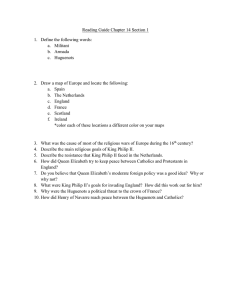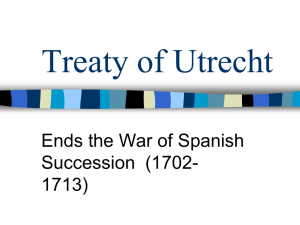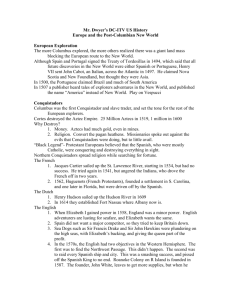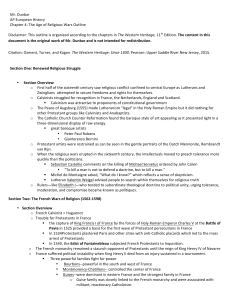Chapter 15 Review Quiz
advertisement
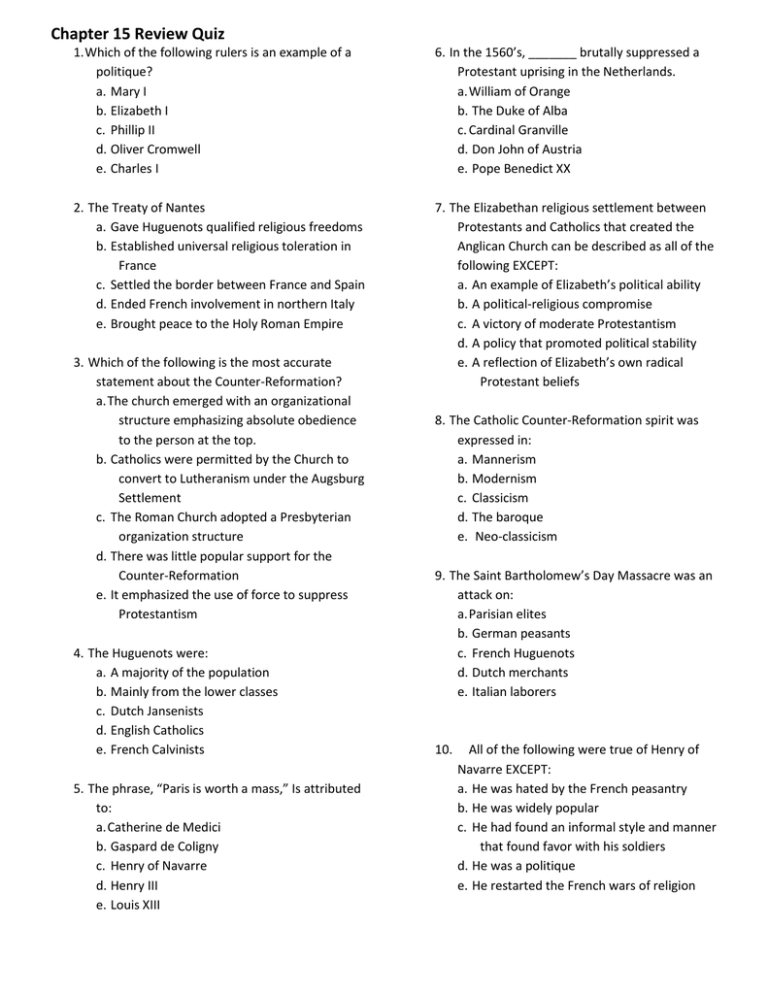
Chapter 15 Review Quiz 1. Which of the following rulers is an example of a politique? a. Mary I b. Elizabeth I c. Phillip II d. Oliver Cromwell e. Charles I 6. In the 1560’s, _______ brutally suppressed a Protestant uprising in the Netherlands. a. William of Orange b. The Duke of Alba c. Cardinal Granville d. Don John of Austria e. Pope Benedict XX 2. The Treaty of Nantes a. Gave Huguenots qualified religious freedoms b. Established universal religious toleration in France c. Settled the border between France and Spain d. Ended French involvement in northern Italy e. Brought peace to the Holy Roman Empire 7. The Elizabethan religious settlement between Protestants and Catholics that created the Anglican Church can be described as all of the following EXCEPT: a. An example of Elizabeth’s political ability b. A political-religious compromise c. A victory of moderate Protestantism d. A policy that promoted political stability e. A reflection of Elizabeth’s own radical Protestant beliefs 3. Which of the following is the most accurate statement about the Counter-Reformation? a. The church emerged with an organizational structure emphasizing absolute obedience to the person at the top. b. Catholics were permitted by the Church to convert to Lutheranism under the Augsburg Settlement c. The Roman Church adopted a Presbyterian organization structure d. There was little popular support for the Counter-Reformation e. It emphasized the use of force to suppress Protestantism 4. The Huguenots were: a. A majority of the population b. Mainly from the lower classes c. Dutch Jansenists d. English Catholics e. French Calvinists 5. The phrase, “Paris is worth a mass,” Is attributed to: a. Catherine de Medici b. Gaspard de Coligny c. Henry of Navarre d. Henry III e. Louis XIII 8. The Catholic Counter-Reformation spirit was expressed in: a. Mannerism b. Modernism c. Classicism d. The baroque e. Neo-classicism 9. The Saint Bartholomew’s Day Massacre was an attack on: a. Parisian elites b. German peasants c. French Huguenots d. Dutch merchants e. Italian laborers 10. All of the following were true of Henry of Navarre EXCEPT: a. He was hated by the French peasantry b. He was widely popular c. He had found an informal style and manner that found favor with his soldiers d. He was a politique e. He restarted the French wars of religion Chapter 15 Review Quiz 11. 12. 13. 14. 15. The inflation of the sixteenth century was the result of: a. The influx of wealth from the New World b. The influx of wealth from the New World and increased population c. An overheated industrial sector of the early modern economy d. The discovery of new deposits of gold and silver in Europe e. Increased population Spanish strength rested on all of the following EXCEPT: a. a subjugated peasantry b. Wealth from the New World c. A vibrant merchant class d. An efficient bureaucracy e. A strong military Spanish dreams of a world empire were undermined by: a. The revolt of Portugal b. Uprisings among the Spanish nobility c. The emergence of a Spanish Protestant movement d. The lack of strong conviction among Spain’s leaders e. The revolt of the Netherlands The unpopularity of Mary I of England was the result of all of the following EXCEPT: a. Her marriage to Phillip II of Spain b. The repeal of Edward’s Protestant statutes c. The reversion to Catholic religious practices d. Her execution of Protestant leaders e. Her lack of legitimacy The deterioration of Spanish relations with England was the result of all of the following EXCEPT: a. England’s increasing hostility to France b. Elizabeth I’s refusal to marry Philip II of Spain c. English intervention in the Netherlands d. The activities of English Pirates e. The execution of Mary Queen of Scots 16. The Spanish invasion fleet that sailed on England in 1588 was known as the: a. Conquesta b. Armada c. Flotilla d. Divine Wind e. Spirit of Vengeance 17. In the second half of the sixteenth century, Germany was made up of: a. Two major kingdoms b. About 360 autonomous political entities c. Four rival political blocs d. Three major kingdoms e. Five rival political blocs 18. In the 1600, the German population was: a. Overwhelmingly Protestant b. Overwhelmingly Catholic c. Made up of roughly equal numbers of Catholics and Protestants d. Among the poorest in Europe e. Overwhelmingly in favor of religious tolerance 19. The Thirty Year’s War first erupted in: a. Bohemia b. Saxony c. Brandenburg d. The Spanish Netherlands e. The Swiss Confederation 20. After the Treaty of Westphalia in 1648, ________ emerged as Europe’s dominant country. a. Spain b. France c. England d. The Holy Roman Empire e. The Netherlands
